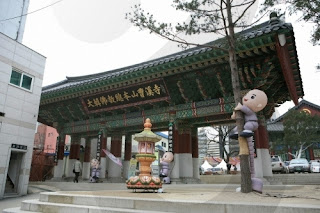The temple is not old, having only been constructed in 1910, but it is particularly significant for the role its monks played in actively resisting changes being forced upon the Korean people by the Japanese occupiers between 1910 and 1945, and then in restoring Korean Buddhist traditions that had been removed by the Japanese. Today, Jogyesa is the spiritual centre of Seon Buddhism (known as Chan in China and Zen in Japan), and is named after the mountain in China where the Sixth Patriarch lived in the 7th Century BCE.
The Daeungjeon or main Buddha hall was built in 1938 (and is currently undergoing major structural renovation) has a simple but extremely elegant construction, with particularly beautiful wooden panels depicting the life of Buddha around the exterior: most of these can be seen even during the renovation work although the light is poor. Inside, the hall can be difficult to explore because of the large numbers of worshippers. The statue of Sakyamuni is believed to date from early on in the Joseon Dynasty. Behind it is a painting of the Vulture Peak Assembly, and this can be difficult to appreciate from the doorway











0 comments:
Post a Comment